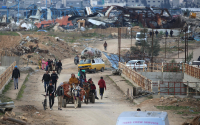Common Dreams / Published on Sunday, September 11, 2005 by Agence France Pres
A new draft US defense paper calls for preventive nuclear strikes against state and non-state adversaries in order to deter them from using weapons of mass destruction and urges US troops to "prepare to use nuclear weapons effectively."
The document, titled "Doctrine for Joint Nuclear Operations" and dated March 15, was put together by the Pentagon's Joint Staff in at attempt to adapt current procedures to the fast-changing world after the September 11, 2001, attacks, said a defense official.
But the official, who spoke to AFP late Saturday on condition of anonymity, said it has not yet been signed by Defense Secretary Donald Rumsfeld and thus has not been made official policy.
"It's in the process of being considered," the official said.
A copy of the draft obtained by AFP urges US theater force commanders operating around the world to prepare specific plans for using nuclear weapons in their regions -- and outlines scenarios, under which it would be justified to seek presidential approval for a nuclear strike.
They include an adversary using or planning to use weapons of mass destruction against US or allied forces as well as civilian populations.
Preventive nuclear strikes could also be employed to destroy a biological weapons arsenal belonging to an enemy, if there is no possibility to take it out with conventional weapons and it is determined the enemy is poised for a biological attack, according to the draft.
They could also be seen as justified to destroy deep, hardened bunkers containing enemy chemical or biological weapons or the command and control infrastructure required to execute a chemical, biological or nuclear attack.
However, a number of scenarios allow nuclear strikes without enemy weapons of mass destruction in the equation.
They could be used, for instance, to counter potentially overwhelming conventional adversaries, to secure a rapid end of a war on US terms, or simply "to ensure success of US and multinational operations," the document indicates.
In the context of the US-led "war on terror", the draft explicitly warns that any attempt by a hostile power to hand over weapons of mass destruction to militant groups to enable them to strike a devastating blow against the United States will likely trigger a US nuclear response against the culprit.
Regional US commanders may request presidential approval to go nuclear "to respond to adversary-supplied WMD use by surrogates against US and multinational forces or civilian populations," the draft says.
The doctrine also gives the Pentagon the green light to deploy nuclear weapons to parts of the world where their future use is considered the most likely and urges troops to constantly train for nuclear warfare.
"To maximize deterrence of WMD use, it is essential US forces prepare to use nuclear weapons effectively and that US forces are determined to employ nuclear weapons if necessary to prevent or retaliate against WMD use," the document states.
The doctrine surfaced after the US Congress moved over the past several months to revive a controversial weapons research program aimed at enabling the US military to conduct precision nuclear strikes against hardened underground facilities.
In separate measures, both the Senate and the House of Representatives approved four million dollars for fiscal 2006 to study the feasibility of the so-called Robust Nuclear Earth Penetrator, also known as the "bunker-buster" bomb, a program that was interrupted last year under intense international and domestic criticism.
Moreover, under the 2002 Moscow Treaty, the United States will be able to retain up to 2,200 operationally deployed strategic nuclear warheads all the way through 2012.
The doctrine reminds that while first use of nuclear weapons may draw condemnation, "no customary or conventional international law prohibits nations from employing nuclear weapons in armed conflict."






